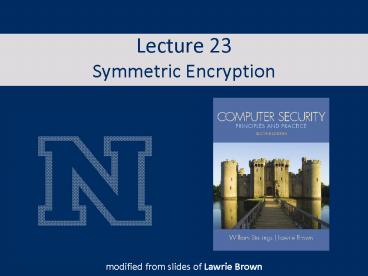Lecture 23 Symmetric Encryption - PowerPoint PPT Presentation
1 / 26
Title:
Lecture 23 Symmetric Encryption
Description:
Title: Computer Security: Principles and Practice, 1/e Subject: Chapter 21 Lecture Overheads Author: Dr Lawrie Brown Last modified by: Kardelen Created Date – PowerPoint PPT presentation
Number of Views:162
Avg rating:3.0/5.0
Title: Lecture 23 Symmetric Encryption
1
Lecture 23Symmetric Encryption
- modified from slides of Lawrie Brown
2
Symmetric Encryption and Message Confidentiality
- also known as conventional encryption,
secret-key, or single-key encryption - only alternative before public-key crypto in 70s
- still most widely used alternative
- has ingredients
- plaintext,
- encryption algorithm,
- secret key,
- ciphertext, and
- decryption algorithm
3
Cryptography
classified along three independent dimensions
- the type of operations used for transforming
plaintext to ciphertext - substitution each element in the plaintext is
mapped into another element - transposition elements in plaintext are
rearranged
- the number of keys used
- sender and receiver use same key symmetric
- sender and receiver each use a different key -
asymmetric
- the way in which the plaintext is processed
- block cipher processes input one block of
elements at a time - stream cipher processes the input elements
continuously
4
Cryptanalysis
- attacks
- ciphertext only - least info, hardest
- known plaintext - some plain/cipher pairs
- chosen plaintext - get own plain/cipher pairs
- chosen ciphertext - rarer
- chosen text - rarer
- only weak algs fail a ciphertext-only attack
- usually design algs to withstand a
known-plaintext attack
5
Computationally Secure Algs
- encryption is computationally secure if
- cost of breaking cipher exceeds info value
- time required to break cipher exceeds the useful
lifetime of the info - usually very difficult to estimate the amount of
effort required to break - can estimate time/cost of a brute-force attack
6
Feistel Cipher Structure
7
Block Cipher Structure
- have a general iterative block cipher structure
- with a sequence of rounds
- with substitutions / permutations controlled by
key - parameters and design features
- block size
- key size
- number of rounds
- subkey generation algorithm
- round function
- also fast software en/decrypt, ease of analysis
8
Data Encryption Standard (DES)
9
Triple DES (3DES)
- standardized in 1999
- uses three keys
- C E(K3, D(K2, E(K1, P)))
- decryption same
- with keys reversed
- use of decryption in second stage gives
compatibility with original DES users - effective 168-bit key length, slow, secure
- AES will eventually replace 3DES
10
AES
Advanced Encryption Standard (AES)
11
AES Round Structure
12
Substitute Bytes
- a simple table lookup in S-box
- a 16?16 matrix of byte values
- mapping old byte to a new value
- e.g. 95 maps to 2A
- a permutation of all possible 256 8-bit values
- constructed using finite field properties
- designed to be resistant to known cryptanalytic
attacks - decrypt uses inverse of S-box
13
S-box
14
Inverse S-box
15
Shift Rows
16
Mix Columns Add Key
- Mix Columns
- operates on each column individually
- mapping each byte to a new value that is a
function of all four bytes in the column - use of equations over finite fields
- to provide good mixing of bytes in column
- Add Round Key
- simply XOR State with bits of expanded key
- security from complexity of round key expansion
and other stages of AES
17
Stream Ciphers
- processes input elements continuously
- key input to a pseudorandom bit generator
- produces stream of random like numbers
- unpredictable without knowing input key
- XOR keystream output with plaintext bytes
- are faster and use far less code
- design considerations
- encryption sequence should have a large period
- keystream approximates random number properties
- uses a sufficiently long key
18
Speed Comparisons of Symmetric Ciphers
- on a Pentium 4
Source http//www.cryptopp.com/benchmarks.html
19
RC4
20
Modes of Operation
- block ciphers process data in blocks
- e.g. 64-bits (DES, 3DES) or 128-bits (AES)
- for longer messages must break up
- and possibly pad end to blocksize multiple
- have 5 five modes of operation for this
- defined in NIST SP 800-38A
- modes are ECB, CBC, CFB, OFB, CTR
21
Electronic Codebook (ECB)
- simplest mode
- split plaintext into blocks
- encrypt each block using the same key
- codebook because have unique ciphertext value
for each plaintext block - not secure for long messages since repeated
plaintext is seen in repeated ciphertext - to overcome security deficiencies you need a
technique where the same plaintext block, if
repeated, produces different ciphertext blocks
22
Cipher Block Chaining (CBC)
23
Cipher Feedback (CFB)
24
Counter (CTR)
25
Location of Encryption
26
Key Distribution
- symmetric crypto needs a shared key
- two parties A B can achieve this by
- A selects key, physically delivers to B
- 3rd party select keys, physically delivers to A,
B - reasonable for link crypto, bad for large nos
users - A selects new key, sends encrypted using previous
old key to B - good for either, but security fails if any key
discovered - 3rd party C selects key, sends encrypted to each
of A B using existing key with each - best for end-to-end encryption
27
Key Distribution
28
Summary
- symmetric encryption principles
- cryptography
- cryptanalysis
- Feistel cipher structure
- data encryption standard
- triple DES
- advanced encryption standard
- algorithm details
- key distribution
- stream ciphers and RC4
- stream cipher structure
- RC4 algorithm
- cipher block modes of operation
- electronic codebook mode
- cipher block chaining mode
- cipher feedback mode
- counter mode
- location of symmetric encryption devices

